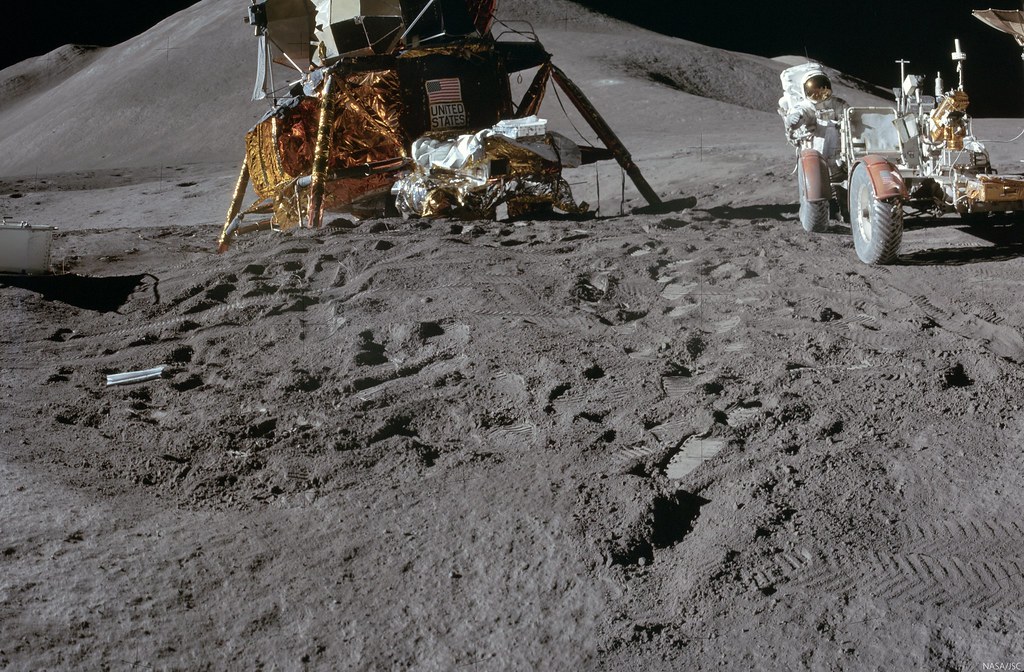 |
| This is another LROC NAC mosaic viewers may really want to see using the "see all sizes" download option that accompany slideshow images in Flickr. An oblique view, looking west over the Apennine Mountains toward Hadley Rille (above -north is to the right). The morning shadows are much as they were July 30, 1971, when Dave Scott and Jim Irwin flew on their backs over range at bottom, flipped forward and landed on the broad plain between those hills and Rima Hadley. Hadley Base, their landing site, and the descent stage of the Apollo 15 lunar module Falcon is right where they left it, just within the resolution of full scale reproductions of this image. |
 |
| Notable features in a thumbnail of LROC NAC oblique mosaic M1123519889LR, LRO orbit 17751, May 18, 2013; spacecraft and cameras slew 55.22° from orbital nadir, 76.87° incidence angle, average resolution 2.87 meters from 130.27 km over 26.11°N, 11.75°E [NASA/GSFC/Arizona State University]. |
LROC News System
Apollo mission planners selected an adventurous landing site for Apollo 15 (26.132219°N, 3.633861°E), on a relatively small patch of lava plains (mare).
This site is nestled between the towering Apennine mountains to the east, attaining heights of 3-5 km, and the 200 meter deep, v-shaped valley of Hadley Rille to the west.
The experience gained from the successful landings of the preceding Apollo missions afforded mission controllers confidence that a landing descending through a mountain range was possible, though it required a steeper descent angle (25° rather than 14°).
captioned video of the descent of Apollo 15 conveys the excitement of astronauts David Scott and James Irwin as they set down near Hadley Rille. The Hadley Rille landing site also presented an opportunity to test the capabilities of the new lunar roving vehicle (LRV).
captioned video of the descent of Apollo 15 conveys the excitement of astronauts David Scott and James Irwin as they set down near Hadley Rille. The Hadley Rille landing site also presented an opportunity to test the capabilities of the new lunar roving vehicle (LRV).
"Down on the plain at Hadley." Newly realigned video (3:37) of the landing of Apollo 15, July 30, 1971. [LunarModule5].
The Apennine Mountain Range formed during the Imbrium basin-forming event, and it was hoped these mountains contained materials from very early in the Moon's history (which they did!). As astronauts Irwin and Scott descended over the Apennines, they reported a floating sensation that resulted from glimpsing mountain peaks passing by the windows of the Lunar Module (LM). The descent was a complete success, and the LM set down near the planned site! Although, the astronauts were a little surprised to land with one foot-pad in a small crater, placing the vehicle on a slant.
 |
| Cmdr. Dave Scott captured this view of the Apollo 15 lunar module Falcon where it came to rest tilting toward the Apennine mountains beyond, while Jim Irwin checked out the first of the three Apollo "J mission" lunar rovers. See full-size mosaic of two color images from the panorama (AS15-86-11600 and 11601) HERE [NASA/JSC/ALSJ]. |
 |
| Thumbnail of a mosaic of black and white images from Science Station 6, during the second EVA of the Apollo 15 expedition, on the slopes of the "Apennine Front." In the full-size panorama, HERE, the lunar module Falcon is visible, several kilometers away, between Hadley rille on the far left and Mt. Hadley, dominating the center of this mosaic [AS15-85-11481-11492, NASA/JSC/ALSJ]. |
 |
| The tiny arrow marks the location of the LM, just barely within the resolution of the LROC NAC mosaic (at full-scale), while LRO orbited over a spot 130 km away. Of course, the landing zone has been documented with remarkable detail from LRO, from better vantages [NASA/GSFC/Arizona State University]. |



No comments:
Post a Comment